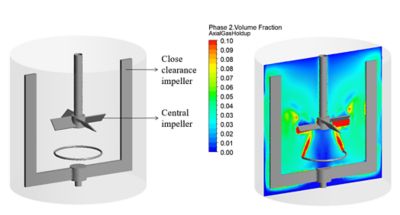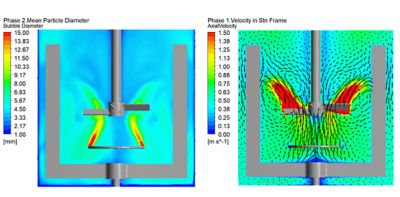Case Study
“The utilization of Ansys solutions in the numerical analysis of coaxial mixer performance, specifically for dispersing gas into non-Newtonian fluids, has significantly enhanced our understanding of complex mixing behavior. Ansys CFD simulations provided invaluable insights by analyzing flow patterns, shear environments, bubble size distributions, viscosity profiles, mass transfer characteristics, and local gas holdup profiles. Moreover, numerical simulations enabled us to identify and mitigate poor mixing in bioprocesses, which ensured uniform gas distribution across the vessel, prevented localized oxygen depletion, and optimized process performance. In fact, Ansys solutions provided essential tools for advancing research and optimizing gas-liquid mixing processes.”
— Paloma Lins Barros, Ph.D. Candidate, Fluid Mixing Technology Research Lab, Toronto Metropolitan University
Given the extensive use of gas-liquid mixing systems, particularly in pharmaceutical bioprocesses, a comprehensive characterization of these operations becomes essential. Engineering simulation is crucial to providing the insights necessary for understanding the process's sensitivity to operating conditions and addressing the challenges in multiphase systems, including the mixing of non-Newtonian fluids. This detailed analysis is valuable for process design and scale-up.
Challenges
Due to challenges in experimental analysis arising from the unfeasible measurement of certain variables, numerical simulation became essential to fully explore gas dispersion within non-Newtonian fluids. To accurately characterize gas-liquid mixing performance using computational fluid dynamics, it was imperative to utilize software capable of handling the complexities of the system.

Figure 1. Coaxial mixer utilized for dispersing gas into a non-Newtonian fluid (left) and the characterization of the gas distribution (right)
Engineering Solutions
- Utilized engineering simulation for multiphase flow analysis to characterize the local volume fraction distribution
- Incorporated a population balance model to predict bubble sizes, considering breakage and coalescence mechanisms
- Employed the Herschel-Bulkley model for modeling complex non-Newtonian biopolymers
- Facilitated easy scale-up of geometry by a geometrical factor
- Leveraged detailed post-processing features for a comprehensive comparison of mixing performance, fluid flow visualization, and calculation of variables using CFX Expression Language

Figure 2. Prediction of the bubble size distribution (left) and flow pattern within the mixing system (right)
Benefits
- Identified optimal operating conditions for mixing performance using engineering simulations within a specified range for anchor-PBT coaxial mixer
- Achieved multiple performance characterizations, including the evaluation of stagnant area, fluid flow, and distribution of bubbles' volume fraction
- Improved process effectiveness in terms of overall gas volume fraction by 71.1%
- Reduced power consumption by 24.8% compared to the maximum power consumption within the range of operating conditions
- Enabled significant time savings for numerical simulations in the design and optimization process, contributing to more efficient research outcomes
Project Description
As a Ph.D. candidate at Toronto Metropolitan University, Paloma Lins Barros is actively engaged in research at the Fluid Mixing Technology Research Lab, which has a legacy of over 15 years. This advanced facility at the university enables researchers to investigate multiphase flow systems, non-Newtonian fluid flow, complex mixing operations, and granular flow. Her academic journey has primarily focused on multiphase fluid flow analysis.
现在就开始行动吧!
如果您面临工程方面的挑战,我们的团队将随时为您提供帮助。我们拥有丰富的经验并秉持创新承诺,期待与您联系。让我们携手合作,将您的工程挑战转化为价值增长和成功的机遇。欢迎立即联系我们进行交流。